double entry in period from 8.07 to 16.07.09, a total of 6 days, currency rate 1 € = 2.3 L (Lari)

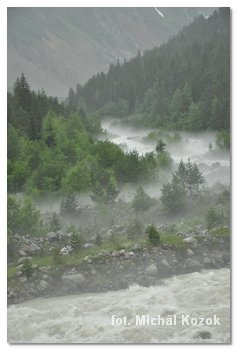 highlights – preparations for the trip – after seeking information on the internet, talking with friends, reading Richard Kapuscinski book "The Kirghiz Dismounts" I expected openness from Georgians. And I was not disappointed – they are nice and hospitable people. Where else in the world a minibus driver buys plums for the passengers, cafeteria owner gives you a free tea, people are happy to store your luggage for free, people do not cheat on bus station, the driver gives you an extra lift without charging for it, taxi drivers give a fair price, etc. We were impressed.
highlights – preparations for the trip – after seeking information on the internet, talking with friends, reading Richard Kapuscinski book "The Kirghiz Dismounts" I expected openness from Georgians. And I was not disappointed – they are nice and hospitable people. Where else in the world a minibus driver buys plums for the passengers, cafeteria owner gives you a free tea, people are happy to store your luggage for free, people do not cheat on bus station, the driver gives you an extra lift without charging for it, taxi drivers give a fair price, etc. We were impressed.
We started with a swim in the Black Sea on the rocky beaches of Batumi. It is a pleasant town surrounded by green hills and blue water. We didn't feel the tense atmosphere of the Adjara republic, the recently rebellious for the independence from Georgia.
Initially we planned to see the Greater Caucasus Mountains Range with his famous Mt Kazbek. Unfortunately the Russian-Georgian conflict for republics of South Ossetia and Abkhazia was just in a period of increased tension. Too bad we had to give up this area, as except its mountains it is famous for picturesquely situated Georgian War Route with many of its monuments (the route ends in Tbilisi). So we changed the plans and went instead 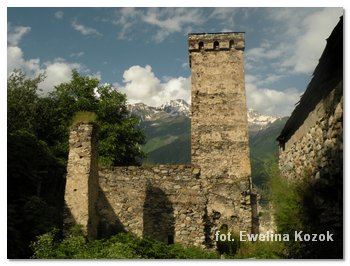
We drove north into the wild mountains of Caucasus. Mesti is the capital of Upper Svaneti, but it's still only a small mountain village (3.500 inhabitants, 1420 m). It is nice here, people are open and there is just a few Western tourists. There are not even a normal cheap restaurants, visitors must prepare hot meals themselves or order that from the accommodation host. Upper Svaneti is known for its medieval towers which can be found in almost every home yard. They were fortified and used as a shelter during family blood revenge conflicts. We went with our backpacks into the mountains in the raining time. I can recommend a two-day trekking near the town.
The first one is to Chigeti Glacier, which has well-marked white-red trail. We walk towards the airport, then continue on a little track upstream, having the river on your left. About 2 hours walking bring us to the rivers fork. There is a hanging bridge and military check point - they look at your passport as you are close to the border with Russia. There is still some 1.5 hours walk through the forest to the glacier feet. We pitched a tent close to the glacier (1820m, N 43°06.924 'E 42°43.748'). The next day we had a surprise - beautiful sun and a wonderful view of rocky peaks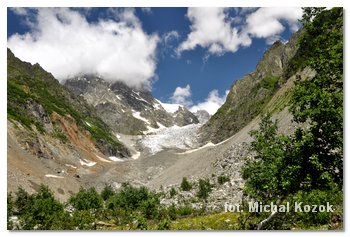 and glacier. From Mesti it is an easy 9 kilometer, 3.5 hour walk, the altitude difference is only 400 meters.
and glacier. From Mesti it is an easy 9 kilometer, 3.5 hour walk, the altitude difference is only 400 meters.
A second walk which I recommend is to visible from the town a large metal cross (2200m, N 43°03.567 'E 42°43.386'). I walked fast by the direct shortest route and it took me 1.5 hour. Views of green meadows and snowy mountain peaks were worth climbing. Locals from the surrounding seasonal summer houses invited me for the homemade yogurt and butter. Women with their flocks live there only during the summer, and when snow covers the grass they are returning to the lower permanent homes. During the descent I chose the western ridge - very steep but clear path took me straight to the main square of Mesti (1 hour).
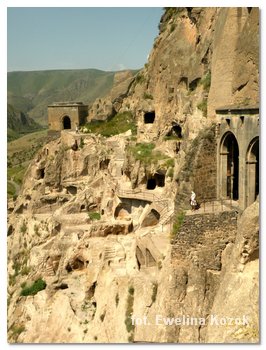
The next day we reached the opposite hill to look at the cave city in the rays of the rising sun. Then we went to explore the sight once again. We left our luggage in the office headquarter without the problem, and we got from them a farewell gift - homemade bottle of wine. This time we bought the tickets and hired the official guide (unfortunately only in Russian). Admission  fee is: normal/student 3/2 L (1.3/0.9 €), guide 10 L (4.3 €) per group. I strongly recommend it - in such places guide is very valuable, he explains what was used for, how it functioned (excellent way of water transport), tell you a bit of history, legends, anecdotes. Thanks to him we also participated in the celebration of the Orthodox Church (by ourselves we would not enter there) - it was Sunday and in one of the thirteenth-century stone chamber the locals gathered for a Mass, led by several bearded monks. Dusk, smell of incense, rising smoke, women with covered heads and with candles in hands, mystical choir, coloured icons and faded frescoes - all made an unique atmosphere.
fee is: normal/student 3/2 L (1.3/0.9 €), guide 10 L (4.3 €) per group. I strongly recommend it - in such places guide is very valuable, he explains what was used for, how it functioned (excellent way of water transport), tell you a bit of history, legends, anecdotes. Thanks to him we also participated in the celebration of the Orthodox Church (by ourselves we would not enter there) - it was Sunday and in one of the thirteenth-century stone chamber the locals gathered for a Mass, led by several bearded monks. Dusk, smell of incense, rising smoke, women with covered heads and with candles in hands, mystical choir, coloured icons and faded frescoes - all made an unique atmosphere. 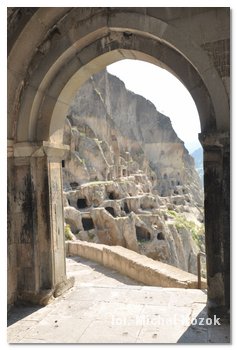 The lack of sight commercialization is something fantastic and unique. It is true that the car park wasn't empty (even a tourist coach appeared), but this is still a little. Anyway this is more about lack of restaurants, advertising, photographers, aggressive taxi drivers, souvenir stalls, expensive tickets etc. The most important of all is that the local mentality is totally different than in other tourist spots – they do not try to make money on you. When we were looking for accommodation the minibus driver took us to the hotel opposite the cave city. We explained that we are looking for a safe place in wild for our tent – the boy who worked there immediately proposed the hotel lawn, brought water to wash, invited for a chat, no charge (there was not a single customer in the middle of summer!). We wondered if we want to come back here in 20 years. I'm afraid that if I do I will be disappointed, due to the current pace of tourism development I do not believe that its negative aspects miss Vardzia (of course, tourism also brings a lot of good things, but that's not what I mean in this case).
The lack of sight commercialization is something fantastic and unique. It is true that the car park wasn't empty (even a tourist coach appeared), but this is still a little. Anyway this is more about lack of restaurants, advertising, photographers, aggressive taxi drivers, souvenir stalls, expensive tickets etc. The most important of all is that the local mentality is totally different than in other tourist spots – they do not try to make money on you. When we were looking for accommodation the minibus driver took us to the hotel opposite the cave city. We explained that we are looking for a safe place in wild for our tent – the boy who worked there immediately proposed the hotel lawn, brought water to wash, invited for a chat, no charge (there was not a single customer in the middle of summer!). We wondered if we want to come back here in 20 years. I'm afraid that if I do I will be disappointed, due to the current pace of tourism development I do not believe that its negative aspects miss Vardzia (of course, tourism also brings a lot of good things, but that's not what I mean in this case).
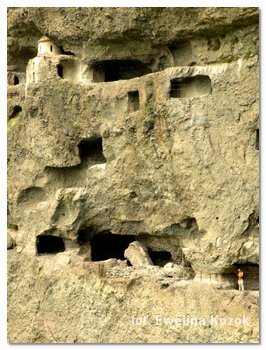 In this area there are also other monasteries. We did not go to the Upper Vardzia - it's a free-standing building (not carved in the rock), around 3 km walk. Fortunately locals recommend us nearby "Zensky Monastery". We had to go back 2 km along the road towards Khertvisi, then turn right and climbed for 15 minutes. Its location, organization, size and age also made an impression. Maybe not as much as main Vardzia monastery, but there were no people (even locals), there were no cash registers or signs. The white chapel integrated into the rocky shelf is especially handsome. We climbed to this church on the old rusty ladders, rock shelves hanging over a rock cliff, winding neglected corridors. Sometimes I had some fear as the steel protections have already been destroyed. Unforgettable impression.
In this area there are also other monasteries. We did not go to the Upper Vardzia - it's a free-standing building (not carved in the rock), around 3 km walk. Fortunately locals recommend us nearby "Zensky Monastery". We had to go back 2 km along the road towards Khertvisi, then turn right and climbed for 15 minutes. Its location, organization, size and age also made an impression. Maybe not as much as main Vardzia monastery, but there were no people (even locals), there were no cash registers or signs. The white chapel integrated into the rocky shelf is especially handsome. We climbed to this church on the old rusty ladders, rock shelves hanging over a rock cliff, winding neglected corridors. Sometimes I had some fear as the steel protections have already been destroyed. Unforgettable impression.
In Khertvisi we visited the castle from the second century BC. We walked inside the ruins, climbed the walls, admiring the views. I wondered again as inside I couldn't find any person charging 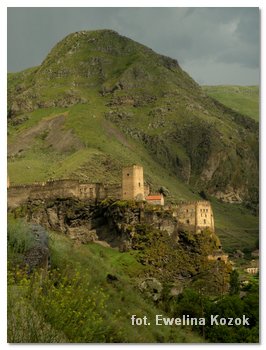
The same day we arrived to Armenia and a few days later returned to Georgia, but through another border crossing. In this way we missed one of the main country attraction - Gori. But for us visiting the Stalin's birthplace, one of the biggest murderers in the world, didn't fall into the regret category.
After returning to Georgia we spent our time in Tbilisi, the capital of the country. We loved the location of the city - it winds along a narrow ravine on both sides of the Kura River. In addition to the arranging an Azerbaijan visa we visited the old town. I liked the Narikala fort (IV century) where is a nice city view (no entry fee). On the river bank we liked charming Metekhi church situated on a vertical rock.
| town | site | price in L | €/ per | duration | note | comments |
| Vardzia | Cave City entry fee | student 2 L/ per | €0.8 | 3 h | super | normal 3 L |
| guide | 10 L/ 2 per | €2.2 | 1.5 h | worth | Russian language | |
| Zensky Monastery | - | - | 1.5 h | worth | ||
| Khertvisi | castle | - | - | 30' | ok | |
| Tbilisi | Narikala fort, Metekhi church | - | - | 2 h | ok | |
| €3 |
![]()
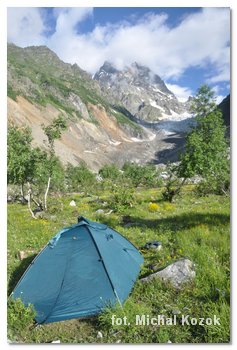 accommodation – Unfortunately, when it comes to accommodation, Georgia was one of the most expensive countries on our route. As hotels listed in the table below, accommodation in the room starts from 20 lari per person (almost 9 €). We offered 5 lari per person in our own tent which we pitched in the courtyard, with the possibility to use the bathroom. The dormitory in the capital was the most expensive in this trip - 6.5 € after bargain.
accommodation – Unfortunately, when it comes to accommodation, Georgia was one of the most expensive countries on our route. As hotels listed in the table below, accommodation in the room starts from 20 lari per person (almost 9 €). We offered 5 lari per person in our own tent which we pitched in the courtyard, with the possibility to use the bathroom. The dormitory in the capital was the most expensive in this trip - 6.5 € after bargain.
Private accommodation in Mesti is on the right side of the road to the airport, pass the bridge, but before the police station (next to guesthouse described in the LP). The owner Irma is a very nice person, she helped us with no interests to store our luggage for period of our trekking. When we returned she wanted lead us to the LP guesthouse (she wanted to be fair to the neighbor). We preferred to stay with her, but the room was too expensive for us - Irma has accepted our proposal to pitch our tent and order her meals.
The hostel atmosphere in Tbilisi is excellent. The owner Irina is very sociable. If you want to book in advance, contact by email - irina5062@gmail.com
| town | hotel and address | N | accommodation | price per night | €/ per | note | comments |
| Zugdidi | hotel with stone tower, next to minibuses to Mesti | 1 | tent | 5 L/ per | €2.2 | 4 | tragic toilet, cold water |
| Mesti | 27 Boris Kakhiani St. ph. 890238009, mob. 0898977238 | 1 | tent | 5 L/ per | €2.2 | 6 | hot shower |
| Tbilisi | Irine Japaridze hostel, Ninoshvili 19B/3, 3rd floor, ph. 995 32954716 | 2 | dormitory | 15 L | €6.5 | 8 | real backpackers |
| in wild | 1 | ||||||
| hospitality | 1 | ||||||
| 6 | €17 (4) |
![]()
transport – there are few buses, but minibuses are everywhere (called here marshrutka). In larger cities minibuses have fixed timetable – you can pay for a ride in the ticket office. That means you do not have to wait hours to fill the vehicle.
The speeding drivers was the first problem. The worst part was on the winding mountain road from Zugdidi to Mesti. We have succeeded, but on the way back we stopped in one place to look at the unlucky one, who had fallen down to the gorge a few days earlier - the view 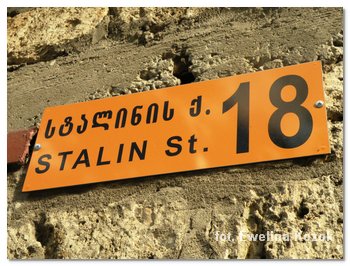
You can get to Mesti from Zugdidi, as the only regular transport is served on this route. On Mesti main squere there is a jeep to Ushgali on Friday afternoon (5 pm), but leaves only when be enough passengers. Coming back from Mesti to Zugdidi is early in the morning (6 am). There was also the only case in Georgia, when the driver demanded the higher fare from us - of course he didn't get it and we paid same as locals, but overall I really liked the honesty of Georgian people. One more surprise - on Tuesdays and Fridays morning there is a small plane between Mesti and Kutaisi (only in good weather condition, Mesti departures at 10 am). Local residents have free ride, but if there is a space in the airplane, they take tourists on the board for a nominal fee 18 Lari (less than 8 €).
When minibus journey has a brake, passengers often sit together and consume a meal. This often involves a vodka drinking (watch what driver is drinking:). There is no quick drinking, as speech has to come before each glass. The vodka toasts are treated quite seriously. Never do a toast with a beer – Georgian might treat it as an insult.
The last minibus from Akhaltsikhe to Vardzia leaves at 5:30 pm.
The city bus in Tbilisi costs 0.4 L (0.2 €)
| day | destination | transport | price in L | €/ per | duration | km |
| 0 - 1 | Antalya (Turkey) - Batumi | bus | data in "cost calculation" | 24 h | Turkey 1520 Georgia 30 | |
| 1 | Batumi - Zugdidi | minibus | 12 L | €5.2 | 2.5 h | 149 |
| 2 | Zugdidi - Mesti | minibus | 15 L | €6.5 | 5 h | 136 |
| 4 | Mesti - Zugdidi - Kutaisi | minibus | 20 L | €8.7 | 6 h | 235 |
| 4 | Kutaisi - Khashuri - Akhaltsikhe | minibus | 10 L | €4.3 | 3 h | 187 |
| 4 | Akhaltsikhe - Vardzia | minibus | 3.5 L | €1.5 | 1.5 h | 62 |
| 5 | Vardzia - Zensky Monastery - Khertvisi | walk + hitchhiking | - | - | 20' + 15' | 2 + 14 |
| 5 | Khertvisi - Akhalkalaki | hitchhiking | - | - | 30' | 26 |
| 5 | Akhalkalaki - Gyumri (Armenia) | hitchhiking | 15 L/ 2 per | €3.3 | 2.5 h | Georgia 41 Armenia 55 |
| stay in Armenia | ||||||
| 7 | Sadakhlo (Armenian border) - Tbilisi | minibus | 15 L/ 2 per | €3.3 | 1 h | 62 |
| 9 | Tbilisi - Krasnyj Most (Azerbaijan border) | minibus | 4 L | €1.7 | 1 h | 57 |
| city transport | bus | 2 L | €0.8 | - | - | |
| €35 | 1001 | |||||
![]()
visa – Georgia was the only country along our route where most nations do not need a visa.